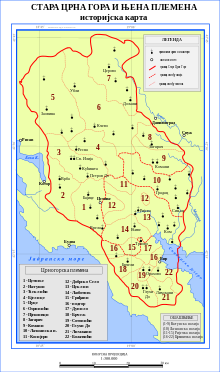Old Montenegro

Map of Old Montegro and nahijas
Old Montenegro (Montenegrin and Serbian: Стара Црна Гора/Stara Crna Gora) is a term used for the embryonic part of modern Montenegro, the territory of the Prince-Bishopric of Montenegro and Principality of Montenegro (as recognised by the Congress of Berlin in 1878) prior to its expansion and eventual proclamation of a kingdom during the Balkan Wars. Before the consolidation of the Montenegrin state, in the Ottoman period (see also Montenegro Vilayet), Old Montenegro was made up of the Montenegrin tribes (Montenegrin and Serbian Latin: crnogorska plemena), simply known as Montenegrins (Montenegrin and Serbian Latin: Crnogorci, as opposed to the Brđani, Hercegovci and Primorci). It included four territorial units, nahije: Katun, Rijeka, Lješanska nahija and Crmnica.
Tribes
Tribes, divided by nahija.
.mw-parser-output div.columns-2 div.column{float:left;width:50%;min-width:300px}.mw-parser-output div.columns-3 div.column{float:left;width:33.3%;min-width:200px}.mw-parser-output div.columns-4 div.column{float:left;width:25%;min-width:150px}.mw-parser-output div.columns-5 div.column{float:left;width:20%;min-width:120px}
|
|
|
|
See also
- History of Montenegro
References
Erdeljanović, Jovan (1926). Стара Црна Гора. Belgrade: SANU..mw-parser-output cite.citation{font-style:inherit}.mw-parser-output q{quotes:"""""""'""'"}.mw-parser-output code.cs1-code{color:inherit;background:inherit;border:inherit;padding:inherit}.mw-parser-output .cs1-lock-free a{background:url("//upload.wikimedia.org/wikipedia/commons/thumb/6/65/Lock-green.svg/9px-Lock-green.svg.png")no-repeat;background-position:right .1em center}.mw-parser-output .cs1-lock-limited a,.mw-parser-output .cs1-lock-registration a{background:url("//upload.wikimedia.org/wikipedia/commons/thumb/d/d6/Lock-gray-alt-2.svg/9px-Lock-gray-alt-2.svg.png")no-repeat;background-position:right .1em center}.mw-parser-output .cs1-lock-subscription a{background:url("//upload.wikimedia.org/wikipedia/commons/thumb/a/aa/Lock-red-alt-2.svg/9px-Lock-red-alt-2.svg.png")no-repeat;background-position:right .1em center}.mw-parser-output .cs1-subscription,.mw-parser-output .cs1-registration{color:#555}.mw-parser-output .cs1-subscription span,.mw-parser-output .cs1-registration span{border-bottom:1px dotted;cursor:help}.mw-parser-output .cs1-hidden-error{display:none;font-size:100%}.mw-parser-output .cs1-visible-error{font-size:100%}.mw-parser-output .cs1-subscription,.mw-parser-output .cs1-registration,.mw-parser-output .cs1-format{font-size:95%}.mw-parser-output .cs1-kern-left,.mw-parser-output .cs1-kern-wl-left{padding-left:0.2em}.mw-parser-output .cs1-kern-right,.mw-parser-output .cs1-kern-wl-right{padding-right:0.2em}
Pavle S. Radusinović (1985). Naselja stare Crne Gore: opšti dio. Srpska akademija nauka i umetnosti.
- L'examen des dialectes du Vieux Monténegro (Stara Crna Gora) en tenant compte des parles voisins, Bulletin international de l' Académie polonaise des sciences et des letters N 1—3 (janvier-mars), 1—13, Cracovie 1932
This Montenegro location article is a stub. You can help Wikipedia by expanding it. |
